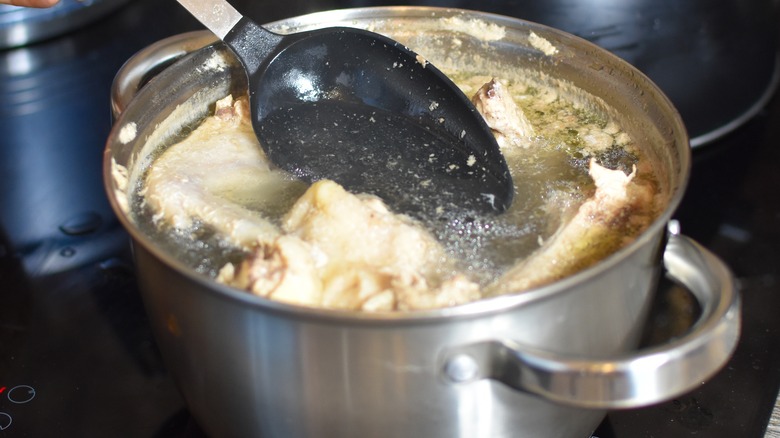The Water Boiling Tip To Avoid Scummy Chicken Stock Floaters
Making chicken stock for the first time can be a daunting task. Even the sight of the whole bird, though technically in its most harmless state, can be enough to elicit a slight panic in even the most intrepid cook, especially if they've only worked with pre-cut parts before. But don't let anyone convince you that there's a high barrier to entry in mastering the perfect chicken stock — and chicken soup, for that matter. Like most things in life, it just takes practice.
If you're midway through cooking a pot of stock for the first time, you might wonder why there's a broken layer of scummy-looking stuff resembling sea foam floating among your chicken and vegetables. Not to fear — that stuff is just rendered fat and protein from your chicken. It's supposed to be there, but it's not supposed to stay. To save you some skimming time, there's a trick to make it a little less profuse.
Keep it low and slow
Your instinct might be to bring your chicken stock to a hard boil as quickly as possible, and indeed plenty of recipes fail to discourage you to do so. But the faster your pot of water heats up, the faster your chicken will start to shed its scummy bits. According to America's Test Kitchen, boiling "emulsifies rendered fat and soluble proteins" in your chicken. While simmering will also lift a layer of fat and protein from the bird, it won't turbo-blast it into you broth. Instead, it'll gently lift it to the top of the pot so you can easily skim it off.
Of course, simmering on lower heat means your chicken will take longer to cook. This isn't necessarily a bad thing. As far as we're concerned, sticking to the "low and slow" method not only yields a clearer broth but also a more flavorful one. According to Food Network star Alton Brown, stock can hang out on the stove for up to six hours. That said, you might only need three.
Get yourself a skimming tool
When it does come time to skim the foam from your pot of broth, it's good to have the right tool. Namiko Hirasawa Chen of the beloved Japanese food blog Just One Cookbook suggests setting up shop with a fine-mesh skimmer and a bowl or measuring cup filled with water. When the foamy stuff begins to rise, scoop it off with your sieve and discard it into your bowl of water. Continue this process anytime you see scum forming as the broth simmers. You can be as diligent or as lackadaisical about it as you wish, but know that less foam will mean a clearer broth in the end.
If you need to start on your soup as soon as possible and you can't get your hands on a skimmer (Chen uses an $8 Hiware one), reach for your nearest slotted spoon. The smaller its perforations, the easier it will be to scoop up large quantities of scum at once.


